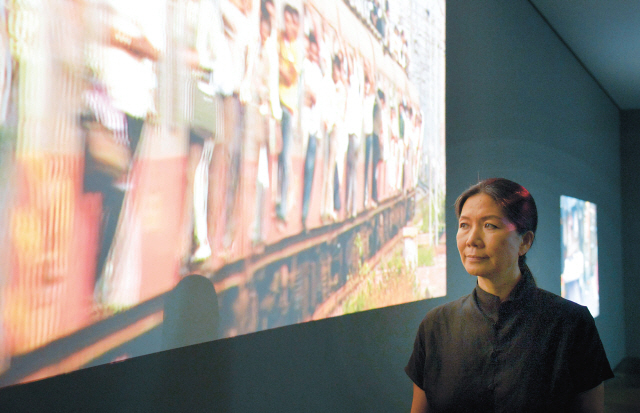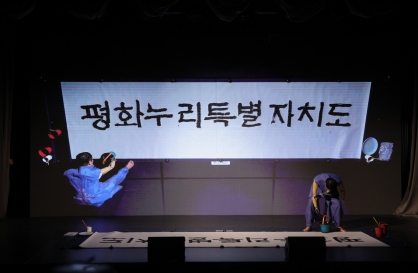Artist Kim Sooja’s multimedia works explore geography and history via focus on fabric
Despite her calm exterior and soothing voice, there is a certain amount of tenseness in Kim Sooja, a Korean artist based primarily in New York ― “primarily” because her work has her on the road for stretches of time.
The palpable tension is a deliberately cultivated one, product of a purposeful decision.
“There are habitual elements that the body feels and you need to work against it. You need tension, awareness,” said Kim over tea at a caf adjacent to the gallery space at Kukje Gallery in Samcheong-dong, Seoul, recently. “You need critical distance.”
In fact, “Cities on the Move-2,727 kilomtres Bottari Truck” which depicts an 11-day journey atop a mountainous pile of bottari, or bundles wrapped in colorful wrapping cloth, visiting various villages from her childhood traveling a distance of 2,727 kilometers completed in 1997 is the last work Kim created in her native land.
“To Breathe,” Kim’s solo exhibition currently on through Oct. 10 at Kukje Gallery, offers highlights from the last 10 years of her prolific career. Ten video works are on show, including the first two chapters from the recently completed 16mm six-part documentary film “Thread Routes.”
“Thread Routes” focuses on sewing and weaving in different parts of the world, shedding light on indigenous culture and the history of the places. Chapter One takes the viewers through the Sacred Valley of Peru near Cusco, Machu Picchu and Tequile Island, all the while exploring the weaving of colorful Peruvian textiles.
Chapter Two, which is being shown for the first time anywhere, chronicles traditional lace-making in various parts of Europe ― Bruges in Belgium, Croatia and Alhambra in Spain.
Kim’s documentaries are site-specific, just as her acclaimed installations have been highly site specific.
“Site specificity is very important in my work,” she says, explaining that she selects her locations through research, through hearing about it or discovers it through reading.
“In ‘Thread Route,’ nature, cultivation field, vegetation, archeological and architectural elements are all very site-specific and these are juxtaposed with local weaving,” Kim says.
Despite her calm exterior and soothing voice, there is a certain amount of tenseness in Kim Sooja, a Korean artist based primarily in New York ― “primarily” because her work has her on the road for stretches of time.
The palpable tension is a deliberately cultivated one, product of a purposeful decision.
“There are habitual elements that the body feels and you need to work against it. You need tension, awareness,” said Kim over tea at a caf adjacent to the gallery space at Kukje Gallery in Samcheong-dong, Seoul, recently. “You need critical distance.”
In fact, “Cities on the Move-2,727 kilomtres Bottari Truck” which depicts an 11-day journey atop a mountainous pile of bottari, or bundles wrapped in colorful wrapping cloth, visiting various villages from her childhood traveling a distance of 2,727 kilometers completed in 1997 is the last work Kim created in her native land.
“To Breathe,” Kim’s solo exhibition currently on through Oct. 10 at Kukje Gallery, offers highlights from the last 10 years of her prolific career. Ten video works are on show, including the first two chapters from the recently completed 16mm six-part documentary film “Thread Routes.”
“Thread Routes” focuses on sewing and weaving in different parts of the world, shedding light on indigenous culture and the history of the places. Chapter One takes the viewers through the Sacred Valley of Peru near Cusco, Machu Picchu and Tequile Island, all the while exploring the weaving of colorful Peruvian textiles.
Chapter Two, which is being shown for the first time anywhere, chronicles traditional lace-making in various parts of Europe ― Bruges in Belgium, Croatia and Alhambra in Spain.
Kim’s documentaries are site-specific, just as her acclaimed installations have been highly site specific.
“Site specificity is very important in my work,” she says, explaining that she selects her locations through research, through hearing about it or discovers it through reading.
“In ‘Thread Route,’ nature, cultivation field, vegetation, archeological and architectural elements are all very site-specific and these are juxtaposed with local weaving,” Kim says.

The transparency of lace featured in Chapter Two is reflected in the Eiffel Tower, the steel tower of the Duomo in Milan, Sedlec Ossuary, a cathedral in the Czech Republic decorated with human bones, and the extreme decorative elements of the Alhambra.
Her documentaries feature carefully chosen sounds, sounds that match the architectural elements. It is thus that the sound of the bobbins during lace-making are paired with the flower pattern of a Santa Barbara Church and bone decorations of Sedlec Ossuary.
The weaving, the architectural elements of the localities and the sounds all form a coherent whole, as if by some grand, overarching design. Yet, Kim’s documentaries are not pre-planned. They are filmed without a script and the pieces are studied after they have been shot.
“I learn new things and get new feelings in the process of working,” she says. “There is a logic of sensibility,” is how she explains the coherent articulation of the completed piece.
The documentaries can be understood even in the absence of words. The understanding is visceral.
“I think people respond emotionally to my works. They are easily understood,” she says.
The next chapter in the “Thread Route” will take the viewers to India. The shooting has been completed and Kim reveals that it will show a nomadic weaving community, block print and embroidery juxtaposed in context of the Sun Temple, primitive housing structures of the nomadic people and the repeated patterns of tattoos sported by the nomadic people.
“There are some very interesting sounds, too,” Kim says.
The localities that Kim selects are all harsh, difficult places and they have all had strong impact on her. In Nepal, there were constant sounds of shooting, Chad is one of the poorest countries on Earth, Cuba was very difficult to get to and India, she finds, is always visually inspiring and culturally enriching. Peru was very unique too.
“I sought out and went to places that have unique cultures, places that were of anthropological interest to me,” she says.
While Kim’s interest in anthropology has led her to create works that are site-specific, her ultimate aim is to blur the geographical and cultural boundaries.
“Moving from place to place, I realized that the world is full of conflicts and that all kinds of boundaries are blocking peace,” she says.
“I became interested in how to reclaim humanity, creating ideal society,” she says, interests which inspired her yet to be unveiled “To Breathe: Olympics” which is to be shown in London. The multimedia work depicts flags of 203 countries overlapping and the interaction of the flags creating a “new flag.”
The work captures the irony of the Olympics. While the Games are hailed as a global gathering of athletes aimed at promoting and friendship, the artist saw how the winner is always the state as symbolized by the raising of the flags at the medal ceremonies.
“I wanted to question the relationship between a nation’s identity and the Olympics,” she says.
The single channel video which was commissioned by the Olympic Committee will become part of the permanent collection at the Lausanne Olympic Museum.
Kim who started out as a painter has experimented with different mediums over the years, including sculpture and installation in addition to video, which she discovered as a medium in 1994.
“This was not necessarily because I was interested in a particular medium. I was interested in the most appropriate methodology for what I wanted to explore at the time.”
While the medium may have changed, the concept of bottari, or wrapping, runs consistently through her works.
“The multimedia documentaries are audio visual wrapping work,” she says, the video framing the world and wrapping it.
Bottari is closely associated with nomadic life, a life on constant move. An anthropologist artist, Kim is an embodiment of her work, traveling to yet another remote part of the world, to wrap up her discoveries in her bottari and return to us, unwrapping her bottari, a new world unfolding before our eyes.
By Kim Hoo-ran (khooran@heraldcorp.com)
-
Articles by Korea Herald






![[Graphic News] Number of coffee franchises in S. Korea rises 13%](http://res.heraldm.com/phpwas/restmb_idxmake.php?idx=644&simg=/content/image/2024/05/02/20240502050817_0.gif&u=)



![[Robert J. Fouser] AI changes rationale for learning languages](http://res.heraldm.com/phpwas/restmb_idxmake.php?idx=644&simg=/content/image/2024/05/02/20240502050811_0.jpg&u=)








